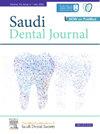Evaluation of the shaping ability of different rotary file systems in severely and abruptly curved root canals using cone beam computed tomography
IF 2.3
Q3 DENTISTRY, ORAL SURGERY & MEDICINE
引用次数: 0
Abstract
Background
When selecting an instrument for canal preparation, it is important to consider several parameters that influence the shaping efficiency, including instrument design, metallurgy, and operating motion. This study aimed to evaluate the shaping ability of the ProTaper Next (PTN), WaveOne Gold (WOG), and XP-endo Rise Shaper (XPRS) rotary systems in severely and abruptly curved root canals using cone beam computed tomography (CBCT) and ImageJ software.
Materials and Methods
Forty-eight mesial root canals of the mandibular first molars were assigned equally to three groups: PTN, WOG, and XPRS. Using ImageJ software, CBCT images were acquired pre- and post-instrumentation to assess dentin removal, remaining dentin thickness (RDT), canal transportation, and centering ratio at the coronal, middle, and apical levels. Statistical analyses were conducted on all numerical data.
Results
All rotary systems removed significantly more distocoronal dentin in the danger zone (DZ), than the mesiocoronal area. PTN removed significantly more dentin and caused less RDT than XPRS (p < 0.05). However, there were no significant differences between PTN-WOG and WOG-XPRS. In the DZ, the highest percentage of specimens with an RDT < 0.5 mm was observed when using PTN (50%), followed by WOG (31.3%), and XPRS (6.3%). Compared with PTN and WOG, XPRS demonstrated less coronal transportation. Among all rotary systems, there was no significant difference in apical transportation or centering ratio.
Conclusions
Based on our observations, all rotary instruments exhibited a tendency to remove dentin in the DZ, but to different degrees. XPRS demonstrated better results in terms of coronal transportation and dentin thickness in the DZ. Comparable centering abilities and minimal apical transportation were demonstrated using all rotary instruments.
使用锥形束计算机断层扫描评估不同旋转锉系统对严重弯曲和突然弯曲根管的整形能力
背景在选择根管预备器械时,必须考虑影响成形效率的几个参数,包括器械设计、冶金和操作运动。本研究旨在使用锥形束计算机断层扫描 (CBCT) 和 ImageJ 软件评估 ProTaper Next (PTN)、WaveOne Gold (WOG) 和 XP-endo Rise Shaper (XPRS) 旋转系统在严重和突然弯曲的根管中的塑形能力:PTN组、WOG组和XPRS组。使用 ImageJ 软件获取器械前后的 CBCT 图像,以评估牙本质去除、剩余牙本质厚度 (RDT)、根管运输以及冠状、中间和根尖水平的居中比率。所有旋转系统在危险区(DZ)去除的远端牙本质都明显多于中端区域。与 XPRS 相比,PTN 切除的牙本质明显更多,造成的 RDT 也更少(p < 0.05)。但是,PTN-WOG 和 WOG-XPRS 之间没有明显差异。在 DZ 中,使用 PTN 时观察到的 RDT < 0.5 mm 标本比例最高(50%),其次是 WOG(31.3%)和 XPRS(6.3%)。与 PTN 和 WOG 相比,XPRS 的冠状位移较少。结论根据我们的观察,所有的旋转器械都有去除DZ内牙本质的倾向,但程度不同。XPRS 在 DZ 的冠状迁移和牙本质厚度方面表现出更好的效果。所有的旋转器械都表现出了相似的定心能力和最小的根尖移位。
本文章由计算机程序翻译,如有差异,请以英文原文为准。
求助全文
约1分钟内获得全文
求助全文
来源期刊

Saudi Dental Journal
DENTISTRY, ORAL SURGERY & MEDICINE-
CiteScore
3.60
自引率
0.00%
发文量
86
审稿时长
22 weeks
期刊介绍:
Saudi Dental Journal is an English language, peer-reviewed scholarly publication in the area of dentistry. Saudi Dental Journal publishes original research and reviews on, but not limited to: • dental disease • clinical trials • dental equipment • new and experimental techniques • epidemiology and oral health • restorative dentistry • periodontology • endodontology • prosthodontics • paediatric dentistry • orthodontics and dental education Saudi Dental Journal is the official publication of the Saudi Dental Society and is published by King Saud University in collaboration with Elsevier and is edited by an international group of eminent researchers.
 求助内容:
求助内容: 应助结果提醒方式:
应助结果提醒方式:


